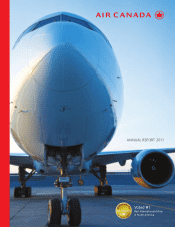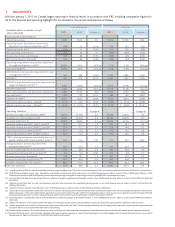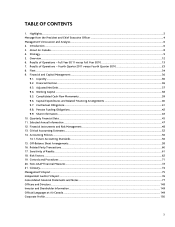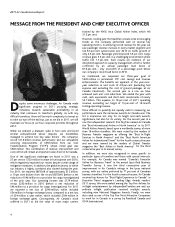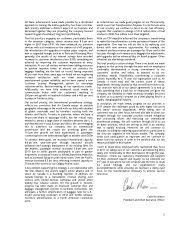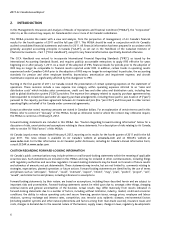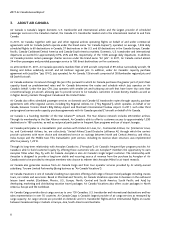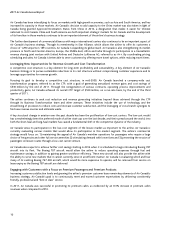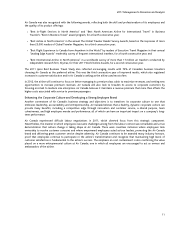Air Canada 2011 Annual Report Download - page 6
Download and view the complete annual report
Please find page 6 of the 2011 Air Canada annual report below. You can navigate through the pages in the report by either clicking on the pages listed below, or by using the keyword search tool below to find specific information within the annual report.2011 Air Canada Annual Report
6
2. INTRODUCTION
In this Management’s Discussion and Analysis of Results of Operations and Financial Condition (“MD&A”), the “Corporation”
refers to, as the context may require, Air Canada and/or one or more of Air Canada’s subsidiaries.
This MD&A provides the reader with a view and analysis, from the perspective of management, of Air Canada’s financial
results for the fourth quarter of 2011 and the full year 2011. This MD&A should be read in conjunction with Air Canada’s
audited consolidated financial statements and notes for 2011. All financial information has been prepared in accordance with
generally accepted accounting principles in Canada (“GAAP”), as set out in the Handbook of the Canadian Institute of
Chartered Accountants – Part 1 (“CICA Handbook”), except for any financial information specifically denoted otherwise.
The CICA Handbook was revised to incorporate International Financial Reporting Standards (“IFRS”), as issued by the
International Accounting Standards Board, and requires publicly accountable enterprises to apply IFRS effective for years
beginning on or after January 1, 2011. As a result of the adoption of IFRS, financial results for periods prior to the adoption of
IFRS may no longer be comparable to financial results reported under IFRS. In addition, certain trends in operating results
experienced under Canadian GAAP prior to the adoption of IFRS may no longer be extrapolated. In particular, the accounting
standards for pension and other employee benefits, depreciation, amortization and impairment expense, and aircraft
maintenance expense are significantly affected by the changeover to IFRS.
Starting in the first quarter of 2011, Air Canada revised the presentation of certain operating expenses on the statement of
operations. These revisions include a new expense line category within operating expenses referred to as “sales and
distribution costs” which includes sales commissions, credit card fees and other sales and distribution costs, including fees
paid to global distribution system (“GDS”) providers. The expense line category related to capacity purchase agreements has
been expanded to include fees paid under all capacity purchase arrangements, including those paid to Jazz Aviation LP (“Jazz”)
pursuant to the capacity purchase agreement between Air Canada and Jazz (the “Jazz CPA”) and those paid to other carriers
operating flights on behalf of Air Canada under commercial agreements.
Except as otherwise noted, monetary amounts are stated in Canadian dollars. For an explanation of certain terms used in this
MD&A, refer to section 21 “Glossary” of this MD&A. Except as otherwise noted or where the context may otherwise require,
this MD&A is current as of February 8, 2012.
Forward-looking statements are included in this MD&A. See “Caution Regarding Forward-Looking Information” below for a
discussion of risks, uncertainties and assumptions relating to these statements. For a description of risks relating to Air Canada,
refer to section 18 “Risk Factors” of this MD&A.
Air Canada issued a news release dated February 9, 2012, reporting on its results for the fourth quarter of 2011 and for the full
year 2011. This news release is available on Air Canada’s website at aircanada.com and on SEDAR’s website at
www.sedar.com. For further information on Air Canada’s public disclosures, including Air Canada’s Annual Information Form,
consult SEDAR at www.sedar.com.
CAUTION REGARDING FORWARD-LOOKING INFORMATION
Air Canada’s public communications may include written or oral forward-looking statements within the meaning of applicable
securities laws. Such statements are included in this MD&A and may be included in other communications, including filings
with regulatory authorities and securities regulators. Forward-looking statements may be based on forecasts of future results
and estimates of amounts not yet determinable. These statements may involve, but are not limited to, comments relating to
strategies, expectations, planned operations or future actions. Forward-looking statements are identified by the use of terms
and phrases such as “anticipate”, “believe”, “could”, “estimate”, “expect”, “intend”, “may”, “plan”, “predict”, “project”, “will”,
“would”, and similar terms and phrases, including references to assumptions.
Forward-looking statements, by their nature, are based on assumptions, including those described herein and are subject to
important risks and uncertainties. Forward-looking statements cannot be relied upon due to, amongst other things, changing
external events and general uncertainties of the business. Actual results may differ materially from results indicated in
forward-looking statements due to a number of factors, including without limitation, industry, market, credit and economic
conditions, the ability to reduce operating costs and secure financing, pension issues, energy prices, employee and labour
relations, currency exchange and interest rates, competition, war, terrorist acts, epidemic diseases, environmental factors
(including weather systems and other natural phenomena and factors arising from man-made sources), insurance issues and
costs, changes in demand due to the seasonal nature of the business, supply issues, changes in laws, regulatory developments

